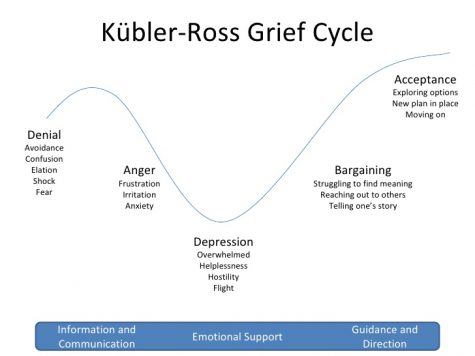What Are We Feeling: The Cycle of Grief
April 14, 2020
In this pandemic, it is hard to describe what we are experiencing and most of us are at a loss for words.
What are we feeling? Grief.
Everything is different right now, and we are experiencing the cycle of grief all at different paces.

The Coronavirus is leaving us at home, living a different, new normal, barely able to leave our houses except for necessities or for work as an essential worker, it’s something we aren’t used to. Personal, face-to-face social interaction has been stripped away from us, besides those we live with, which can cause a feeling of loss and grief.
David Kessler is founder of grief.com and author to several books on grief. “We’re feeling a number of different griefs. We feel the world has changed, and it has. We know this is temporary, but it doesn’t feel that way, and we realize things will be different,” Kessler said to Harvard Business Review. “The loss of normalcy; the fear of economic toll; the loss of connection. This is hitting us and we’re grieving. Collectively.”
Day-by-day our emotions towards this situation are evolving, and they can best be described by the Kübler-Ross model which outlines the five stages of grief: denial, anger, bargaining, depression and acceptance.
1.Denial
Shown through the disbelief and resistance to the facts, this is an evolutionary technique for survival to reject something that is obvious.
“Evolution has created in humans the ability to deny both physical and emotional pain for a short period of time in the service of self-preservation,” according to Psychology Today.
Denial, in the current climate we are in, could be saying that this is all overhyped, it’s not that big of a deal, comparing it to the flu and how many people die of it, or just saying that you are immune because you’re healthy and not old.
2. Anger
According to Psychology Today, “We move toward anger in an attempt to gain control over our fears. Rather than accepting and dealing with the problem, we turn hostile, blaming others, engaging in power struggles, externalizing the issue, and, sometimes, refusing to comply with the rules.”
The characteristics include being outraged and blaming others, maybe even finding a target for your anger whether it be an inanimate object or people around you.
This can be seen now blaming China or those who traveled, going against what the government is saying or against the quarantine. Specifically, for students, this could be blaming the school district for canceling school, or the governor for the quarantine, then not listening to these stay-at-home orders in spite of it.
3. Bargaining
“Bargaining occurs when denial breaks down and we start to acknowledge reality but we’re not ready to give up the illusion that we still have control,” Psychology Today said. “Basically, we try to compromise to find an easier, less painful way out.”
Trying to regain control of the situation due to our feelings of helplessness, thus a bunch of “what if” statements, attempting to bargain or postpone the inevitable. It is an escape from the pain and gives hope.
This can be seen by saying it is going to end soon, or still seeing people and swearing they are healthy. While there is growth in the perspective, there are trade-offs to help benefit them.
4. Depression
The immediate future during this pandemic is dim and seeing all the negativity around it all can leave people stuck in this stage for quite a while. This is the feeling of helplessness and that there is no hope. Symptoms include intense sadness, loss of motivation, reduced appetite and decreased sleep.
“Despair and depression occur when reality fully sets in when there is no more room for denial,” Psychology Today continued. “There is a sense of hopelessness, a feeling that we are fully disempowered and all is lost. We engage in self-pity. We think that nothing can help now, despite evidence to the contrary. We rue the fact that our attempts at bargaining haven’t worked.”
In the current situation, this could include not going to work or doing schoolwork, feeling the loss of the future or isolating yourself even more with no online presence.
This stage can be hard to get out of, but reach out and talk to others. This stage of grieving is valid and is an appropriate response to what is happening. A few things to help get to the next stage is to allow yourself to have those feelings and not suppress your emotions. Express those feelings to others and in creative ways.
5. Acceptance
The last step is accepting the reality of the situation and that there is no control of it, that we must live with what is happening.
Psychology Today stated, “Acceptance occurs when we finally acknowledge and surrender to the facts, whatever those facts happen to be. When we reach this stage, we can stop denying and fighting reality, and we can start dealing as effectively as we can with what has happened and what is happening.”
Acceptance during this time includes acknowledging that you can’t control the pandemic, but there are things you can do to slow it down. You can find other outlets and not view being at home as hopeless, and start to envision a hopeful future for what happens after all of this.
These stages should give insight into what we are feeling. Some may take longer in some stages than others, but overall, at one point, acceptance is there at the end. All feelings are valid and good to feel in order to progress.




